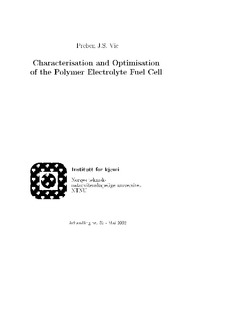| dc.contributor.author | Vie, Preben J.S. | nb_NO |
| dc.date.accessioned | 2014-12-19T13:11:01Z | |
| dc.date.available | 2014-12-19T13:11:01Z | |
| dc.date.created | 2002-05-06 | nb_NO |
| dc.date.issued | 2002 | nb_NO |
| dc.identifier | 126370 | nb_NO |
| dc.identifier.isbn | 82-471-5431-5 | nb_NO |
| dc.identifier.uri | http://hdl.handle.net/11250/244546 | |
| dc.description.abstract | This thesis presents work performed on five subjects of the polymer fuel cell:
• A polymer fuel cell test-facility was optimised. A fuel cell housing was designed and built, enabling measurements of ocal fuel cell temperatures. The fuel cell voltage was measured between the gas diffusion backings using thin platinum wires. This assures that the true fuel cell voltage is measured.
• The Nafion® content and content of Acetylene Black in the fuel cell electrode was optimised in a 32 – factorial experiment. The amount of Nafion varied between 15,25 and 35 wt%, and Acetylene Black varied at 0, 5 and 10 wt%. The data was analysed with the Bootstrapping method, and reproducibility was assedded. The optimal amount for the Acetylene Black content.
• A novel fuel cell membrane was tested in the polymer fuel cell. The membrane was a proton irradiated and directly sulfonated poly(vinyl fluride) (PVF.SA) membrane. The performance was lightly better than for a Nafion® 117 membrane tested under the same conditions.
• A fuel cell model based on irreversible thermodynamics was presented. The model was a one-dimensional model solving the heat and water transport perpendicular to the membrane surface. A potential and temperature profile was calculated, based on literature data. Temperatures inside the membrane (Nafion® 117) were estimated to be 5°C higher at 1 A/cm2 in the gas channels.
• The local temperatures were measured inside the polymer fuel cell. At 1 A/cm2 the temperature difference between gas channel and membrane was measured to 6°C. The thermal conductivities in the membrane, backing and catalytic layer were estimated from temperature measurements. The thermal conductivity of the gas diffusion backing with electrode was 0.19 ± 0.05 Wmk and the thermal conductivity of the Nafion® 115 membrane was wstimated to 0.1 ± 0.1 W/mK. The heat-transfer coefficient of the electrodes was calculated to 1000 ± 300 W/m2K. | nb_NO |
| dc.language | eng | nb_NO |
| dc.publisher | Fakultet for naturvitenskap og teknologi | nb_NO |
| dc.relation.ispartofseries | Dr. ingeniøravhandling, 0809-103X; 2002:37 | nb_NO |
| dc.relation.haspart | Vie, Preben J.S.; Paronen, Mikael; Strømgård, Monica; Rauhula, Eero. Fuel cell performance of proton irradiated and subsequently sulfonated poly(vinyl fluoride) membranes. Journal of Membrane Science. 204(1-2): 295-301, 2002. | nb_NO |
| dc.relation.haspart | Vie, Preben J.S.; Kjelstrup, Signe; Bedeaux, Dick. Polymer fuel cells described by irreversible thermodynamics. Surface chemistry and electrochemistry of membranes, 1999. | nb_NO |
| dc.subject | Brenselceller | no_NO |
| dc.title | Characterisation and optimisation of the polymer electrolyte fuel cell | nb_NO |
| dc.type | Doctoral thesis | nb_NO |
| dc.source.pagenumber | 155 | nb_NO |
| dc.contributor.department | Norges teknisk-naturvitenskapelige universitet, Fakultet for naturvitenskap og teknologi | nb_NO |
| dc.description.degree | dr.ing. | nb_NO |
| dc.description.degree | dr.ing. | en_GB |
